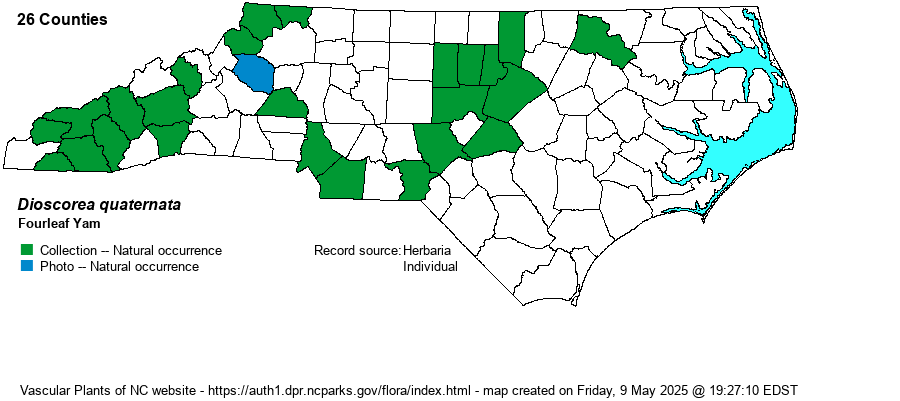| Author | Walter ex Gmelin | |
| Distribution | The present map represents just those specimens determined as "D. quaternata". All records are from the Piedmont and Mountains. This form likely occurs in other counties in these provinces. It is likely that many Piedmont records previously assigned to V. villosa belong to this controversial taxon. Weakley (2020) does not treat this taxon, other than include it within D. villosa; NatureServe does consider it as a good species, but BONAP and Flora of North America (FNA) do not.
PA to IN and MO, south to northwestern FL and LA -- apparently mostly in the Mountain and Piedmont regions in the Atlantic states. | |
| Abundance | Apparently common across all of the Mountains and lower Piedmont; absent from the Sandhills and Coastal Plain. The NCNHP rank of S4 is acceptable, considering its commonness in the Piedmont and Mountains. The website editors suggest S5? for it, as it is not hard to find. However, because Weakley (2020) has moved it back into D. villosa, it must be given a State Rank of SYN = Synonym, until such time as someone annotates specimens and publishes a revision. | |
| Habitat | Mesic to moist forests, rocky slopes, riverside slopes and ledges; probably all NC populations are from or near brownwater systems. |
| Phenology | Flowering late April-June; fruiting September-October. | |
| Identification | Fourleaf Yam differs from Yellow Yam (D. villosa) in its whorled basal leaves (usually 4 leaves, but can have 5-7 such whorled leaves) vs. not whorled (may be close to each other but not truly whorled). The entire stem is smooth vs. pubescent or smooth in Yellow Yam. Gleason (1952) states that fruits of Fourleaf Yam are a bit larger, but gives no measurements. In the field, leaves and stems of Fourleaf Yam appear glaucescent vs. plain green of V. villosa. | |
| Taxonomic Comments | Taxon editors believe that D. quaternata will eventually be split from D. villosa, as it was treated by Gleason (1952). In fact, NatureServe considers this taxon as a valid species -- with a G5 Global Rank -- without the Q for Questionable taxonomy. These differences, especially whorled basal leaves versus non-whorled, seem distinct at a taxonomic level.
| |
| Other Common Name(s) | American Fourleaf Yam. Note that "Wild Yam" is typically used for the combined D. villosa complex. With NatureServe splitting out D. quaternata as a good species, it has named its D. villosa (strict sense) as Yellow Yam. | |
| State Rank | S4 [SYN] | |
| Global Rank | G5 | |
| State Status | | |
| US Status | | |
| USACE-agcp | | |
| USACE-emp | | |

